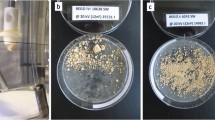Summary
Second generation lithotripters require a higher number of shocks per session as well as an increased rate of secondary treatments for complete stone disintegration compared to the original spark gap lithotripter. The clinical relevance of biological side effects caused by such treatment are less known. We evaluated urinary excretion of N-acetyl-glucosaminidase (NAG) before and after lithotripsy in 50 patients treated with a low pressure spark gap lithotripter (Dornier HM3) and in 36 patients treated with a piezoelectric lithotripter (Wolf Piezolith 2200) in an attempt to evaluate their side effects on renal tissue. The urinary excretion of NAG increased after both spark gap lithotripsy using the modified HM3 and piezoelectric lithtripsy. These changes may be associated with slight tubular damage that would occur after anesthesia-free lithotripsy in patients subjected both to a high number of shocks and to secondary treatments.
Similar content being viewed by others
References
Chaussy C (1982) In vitro and in vivo studies on biological systems. In: Chaussy C (ed) Extracorporeal shock wave lithotripsy. Karger, Basel, p 21
Gilbert BR, Riehle RA, Vaughan ED Jr (1988) Extracorporeal shock wave lithotripsy and its effect on renal function. J Urol 139:482
Graff J, Schmidt A, Pastor J, Herberhold D, Rassweiler J, Hankemeier U (1988) New generator for low pressure lithotripsy with the Dornier HM3: preliminary experience of 2 centers. J Urol 139:904
Grantham JR, Millner MR, Kaude JV, Finlayson B, Hunter PT, Newman RC (1986) Renal stone disease treated with extracorporeal shock wave lithotripsy: short-term observations in 100 patients. Radiology 158:203
Jaeger P, Redha F, Uhlschmid G, Hauri D (1988) Morphological changes in canine kidneys following extracorporeal shock wave treatment. Urol Res 16:161
Kaude JV, Williams CM, Millner MR, Scott KN, Finlayson B (1985) Renal morphology and function immediately after extracorporeal shock-wave lithotripsy. AJR 145:305
Kishimoto T, Yamamoto K, Sugimoto T, Yoshihara H, Maekawa M (1986) Side effects of extracorporeal shock-wave exposure in patients treated by extracorporeal shock-wave lithotripsy for upper urinary tract stone. Eur Urol 12:308
Marberger M, Turk C, Steinkogler I (1988) Painless piezoelectric extracorporeal lithotripsy. J Urol 139:695
Pisani E, Zanetti GP, Trinchieri A, Mandressi A, Montanari E, De Franco S (1985) Markers of tubular damage after renal surgery: an experimental study. In: Jardin A (ed) XX Congres de la Société International d' Urologie, Paris, p 350
Rubin JJ, Arger PH, Pollack HM, Banner MP, Coleman BG, Mintz MC, Van Arsdalen KN (1987) Kidney changes after extracorporeal shock wave lithotripsy: CT evaluation. Radiology 162:21
Ruiz Marcellan FJ, Ibarz Servio L (1986) Evaluation of renal damage in extracorporeal lithotripsy by shock waves. Eur Urol 12:73
Trinchieri A, Mandressi A, Zanetti G, Ruoppolo M, Tombolini P, Pisani E (1988) Renal tubular damage after renal stone treatment. Urol Res 16:101
Author information
Authors and Affiliations
Rights and permissions
About this article
Cite this article
Trinchieri, A., Zanetti, G., Tombolini, P. et al. Urinary NAG excretion after anesthesia-free extracorporeal lithotripsy of renal stones: a marker of early tubular damage. Urol. Res. 18, 259–262 (1990). https://doi.org/10.1007/BF00294769
Accepted:
Issue Date:
DOI: https://doi.org/10.1007/BF00294769




